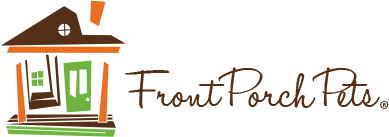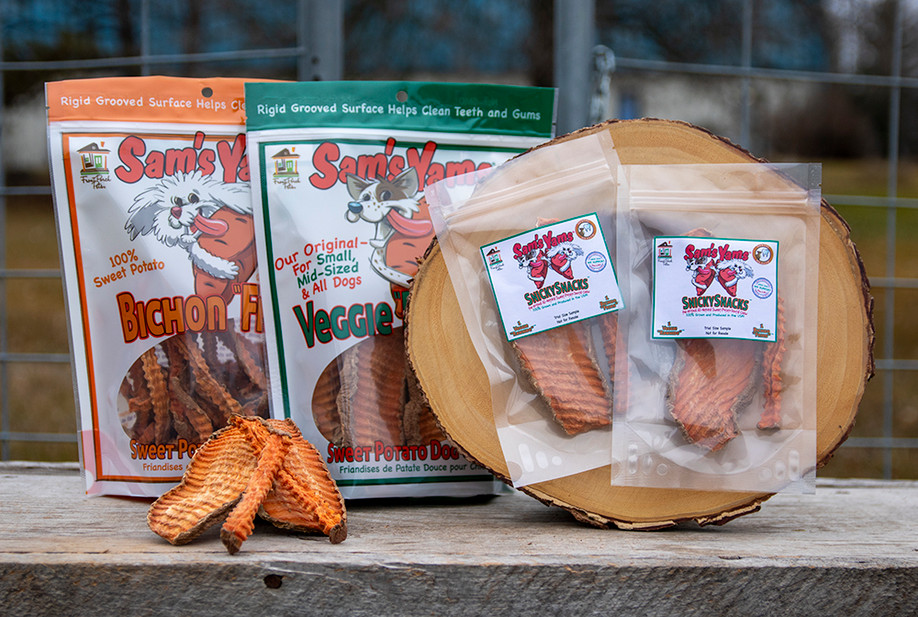"The Best Way to Predict The Future Is To Create It." Buckminster Fuller.
Today starts a new year. 2020 is a very exciting and promising year for FPP as we will finally offer, for the first time in our seventeen- year history, meat- based treats, chews and provisions for making pet foods.
Our flagship dental offering, Sam’s Yams Sweet Potato Dog Chews, has been our foundational product from which we have created a wide variety of sweet potato- based treats. All of our treats have been vegetable, fruit and botanical formulations. We grow many ingredients ourselves in gardens, greenhouse and orchard.
Over the years however, we have been asked by store owners and home customers to apply the same level of quality and integrity to a meat- based treat for their companion animals too. This goal has resided for more than a decade on the R and D kitchen things to do list. One would think that my work background as a Product Development chef would make this a simple and quick project. The opposite is actually true. Creating dog treats from meats is not the challenge but in finding meats that I believe in is. After years of going to pet food ingredient trade shows and requesting numerous samples I find little that I believe will support the health of your animals for many years to come.
From the point of view of a chef any recipe starts with a list of ingredients. The best ingredients simply prepared usually make the best tasting and often healthiest meals. In making any food or feed for animals that will be sold into distribution, one will need to consult the AAFCO manual right from the start and be prepared to follow their guidelines.
Look on the side or back of any bag of pet food or treats and you will find the statement “meets the nutritional guidelines established by the AAFCO”, that being the American Association of Feed Control Officials. A private organization that nonetheless writes the rules for what is acceptable in the making of pet foods. Every state Agricultural Department has adopted them and those employed in those state positions form the membership of the AAFCO. The Manual costs $250 and is updated annually. My first copy was purchased in 2006.
Besides the actual rules and regulations sections of the AAFCO manual there are copious lists of ingredients, with descriptions, of which are allowed for use in making animal feed. There are thousands of ingredients listed. Few you would recognize. Mostly industrial terms referring to some waste product or derivative from making a human grade product. Mostly something you would not find in your pantry.
So, here’s my problem. I’m coming from the chef coat side of making pet food as opposed to the lab coat side. There are no lists of thousands of products one uses when creating recipes and menus from real foods. A real food list appears more like a shopping list: carrots, potatoes, chicken, flank steak etc. etc.
The two lists, the AAFCO approved list verses the real food list, have almost nothing in common. I will save future posts to get into this area with you in more detail. Check back on future posts, it will be quite interesting indeed.
Suffice it to say there’s few food products listed in the AAFCO manual that I will feed my pets or even the cattle, chickens, ducks, turkeys or pheasant we have been pasturing and feeding for the last five years. We use no commercially prepared feeds for any of our animals besides some organic chicken starter feed. We purchase our ingredients, all Non- GMO, and then mill and mix them ourselves. The milling and mixing part reminds me very much of my baking days, we are even using the same stone mill I used for my bakery in New Mexico some years back. Our shopping list for feeding our livestock and our pets looks very much like a shopping list you would recognize yourself.
It has taken me this many years to add meat products because it has taken me this many years to understand what I am willing to use in treats and what I am not. In other words, What To Leave In and What to Leave Out, just as Bobby Segar sang about back in the day. That song routinely pops into my consciousness these last few years. At my age of sixty- seven there is a reason for that. When contemplating the times we live in, the potential for the serious ramifications upon mother earth that the industrial food and agricultural systems are creating, any serious person must begin to dig in and do those things that can help slow or stop this slide. Soul searching. Again, What to Leave In What to Leave Out. Producing a thing as simple as a pet treat is far more revolutionary than one might think when you consider the “what you leave out” part is the change left on the table from the industrial food system and that makes them just that much less profitable if not being used in pet foods. Yeah, it’s about money.
I want to clarify our position and our guiding philosophy on making foods for animals. Rather than state what we will do let’s start with what we won’t. Subtracting out what we will not do helps us focus on what we will do and might be helpful to you in knowing these things about us.
So here it is.
We are not going to grow our business model designed upon CAFO meats and the by-products thereof.
Concentrated Animal Feeding Operations treat living animals as things. When you have been raised with cats, dogs, birds and the like, and then have gone further by rescuing the same you find that each animal is a personality. You love many of them and for others, it’s at least deep like! Now that we have over one hundred egg laying chickens of probably eight varieties, I do not know of any team member that does not take a liking to them and invariably one or two birds more than the others. Why is that? It’s because they are funny or boisterous or pushy or beautiful or whatever but they are not a thing. More than one team mate has taken to chickens to the point they build elaborate homes for them at their own domiciles.
We are not going to practice farming techniques that take from the soil rather than build upon the soil. Soil is everything. That and water. Both together and you have life. Teaming with possibilities. So that means organic techniques. No large scale monocultures. No GMO. The practices we have embraced are regenerative agriculture and permaculture.
We are not going to poison the wildlife that we are so fortunate to have all around us. We are going to learn to live with them as best we can while protecting our livestock the best we can. This involves electric perimeter fencing and strategies to prevent dive bombing eagles, hawks and owls from making dinner of our poultry. We have a mule that stands guard over our goats and pony. Our trail cameras have picked up on foxes, bobcats, coyotes, bears and our good friend, Leyton Cougar, aka Wolf Daddy, has encountered a pair of wolves trotting down a farm pathway as well. We will not participate in the use of scented bates or cyanide bombs. Not on our watch!
We buy no ingredients from China and that includes the vitamins, minerals and supplements of which I’m told, ninety percent of begin in China. I still remember melamine - i bet you do too. We use no palm products and that includes vegetable glycerin which is a byproduct of processing palm oils. From our point of view orangutan are people too! We are not about to ship meat across the big Pacific and then across the States from New Zealand and Australia. The meat "proteins" we use come from our farm and ranch or from other nearby farmers that we know by name.Though folks in the commercial pet food world talk "proteins", farmers talk chickens, ducks, turkeys and cattle. Beyond that specific breeds, specific purpose, personality and needs.
This boils down to, we support local.
We will not raise Cornish White Cross chickens that have a mere six to eight- week lifespan on this beautiful planet. We want our animals to at least spend a few seasons in the sun, wind, rain and stars, Eating bugs and grass and some of the good mash we feed them. We raise about ten varieties of laying hens and meat birds, plus heritage turkeys, ducks, pheasant and a handful of guinea hens.
Along these lines we will not use chicken fat with mixed tocopherols. Not unless it is organic. Or from our chickens. It is fairly well understood that heavy metals and toxins are stored in fat.
Right NOW we are practicing regenerative agriculture to bring back the abandoned quarry that is part of our property with gardens and greenhouse. On pasture, our twenty-some head of Highland cattle and Belted Galloways are moved daily to fresh grasses. This will help build the perennial roots on our sandy piece of prairie, locking up carbon from the air into the soil, roots and woods we oversee.
This is the only way I could see fit to adding meat to our present line up of Veggie treats and chews. It takes time to learn how to do all of this and why it is important. Hope you appreciate the bone broths and Pemmican treats that result from this garden and pasture of ours.
We are not practicing the usual business practices of grow, grow, grow. We will take care of what we are given to care for. Nor will we subscribe to the other business maxim that a company’s only social responsibility is to create a profit. Yes, we must profit but we must also cultivate relationships that have staying power right here in Wild Rose, where we live and work.
Finally, I’m not, and I don’t think any one of us are, contemplating a move to Mars. Elon Musk, Bon Voyage and I’m sorry Stephen Hawking didn’t live long enough to take the trip with you. No, we don’t think there is a Planet B option or nearby planetary possibilities any time soon. We love this planet. We are digging in. We are being good boy scouts and girl scouts and leaving this place better than when we arrived.

